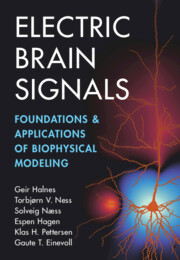Book contents
- Frontmatter
- Dedication
- Contents
- Preface
- Reserved Physical Symbols and Quantities
- Abbreviations
- 1 Introduction
- 2 Charges, Currents, Fields, and Potentials in the Brain
- 3 Neural Dynamics
- 4 Volume-Conductor Theory
- 5 Conductivity of Brain Tissue
- 6 Schemes for Computing Extracellular Potentials
- 7 Spikes
- 8 Local Field Potentials (LFPs)
- 9 Electroencephalography (EEG)
- 10 Electrocorticography (ECoG)
- 11 Magnetoencephalography (MEG)
- 12 Diffusion Potentials in Brain Tissue
- 13 Final Comments and Outlook
- Appendix A Frequency-Dependent Length Constant
- Appendix B Derivation of the Current-Dipole Approximation
- Appendix C Electric Stimulation
- Appendix D Derivation of the Point-Source Equation for Anisotropic Medium
- Appendix E Statistical Measures
- Appendix F Fourier-Based Analyses
- Appendix G Derivation of Formulas for Population Signals
- Appendix H Equations for Computing Magnetic Fields
- Appendix I Derivation of the MC+ED Scheme
- References
- Index
7 - Spikes
Published online by Cambridge University Press: 30 May 2024
- Frontmatter
- Dedication
- Contents
- Preface
- Reserved Physical Symbols and Quantities
- Abbreviations
- 1 Introduction
- 2 Charges, Currents, Fields, and Potentials in the Brain
- 3 Neural Dynamics
- 4 Volume-Conductor Theory
- 5 Conductivity of Brain Tissue
- 6 Schemes for Computing Extracellular Potentials
- 7 Spikes
- 8 Local Field Potentials (LFPs)
- 9 Electroencephalography (EEG)
- 10 Electrocorticography (ECoG)
- 11 Magnetoencephalography (MEG)
- 12 Diffusion Potentials in Brain Tissue
- 13 Final Comments and Outlook
- Appendix A Frequency-Dependent Length Constant
- Appendix B Derivation of the Current-Dipole Approximation
- Appendix C Electric Stimulation
- Appendix D Derivation of the Point-Source Equation for Anisotropic Medium
- Appendix E Statistical Measures
- Appendix F Fourier-Based Analyses
- Appendix G Derivation of Formulas for Population Signals
- Appendix H Equations for Computing Magnetic Fields
- Appendix I Derivation of the MC+ED Scheme
- References
- Index
Summary
When a neuron fires an action potential, it causes a rapid fluctuation in the extracellular potential. This fluctuation is referred to as a spike and is normally “visible” only close to the neuron it originates from. Spikes are typically studied experimentally by high-pass filtering the extracellular potential. Here, we use computer simulations and approximate analytical formulas of spikes to explore how the amplitude and shape of spikes depend on various factors such as (i) the morphology of the neuron, (ii) the presence of active ion channels in the neuron’s dendrites, (iii) the part of the neuron (soma vs. dendrite) where the spike is recorded, (iv) the distance from the neuron the spike is recorded, and (v) the location in the neuron that the action potential is initiated. We also briefly discuss how the presence of the electrode can affect spike recordings as well as how to analyze data containing overlapping spikes from several neurons simultaneously.
Keywords
- Type
- Chapter
- Information
- Electric Brain SignalsFoundations and Applications of Biophysical Modeling, pp. 158 - 186Publisher: Cambridge University PressPrint publication year: 2024



